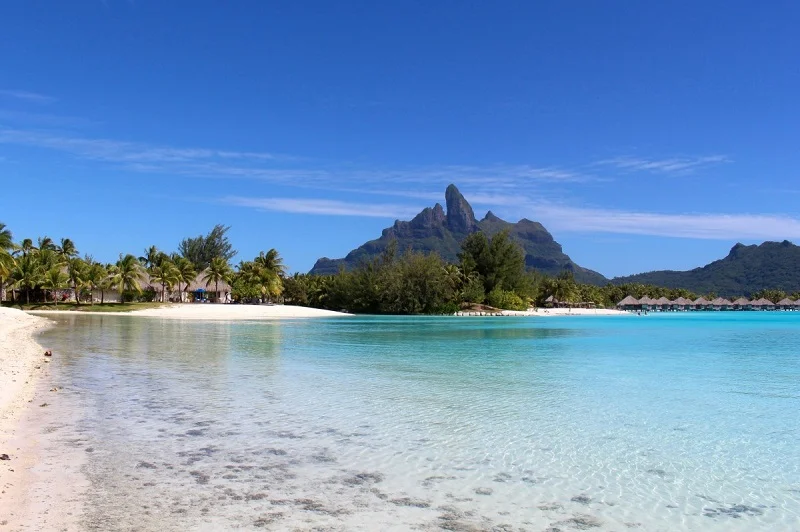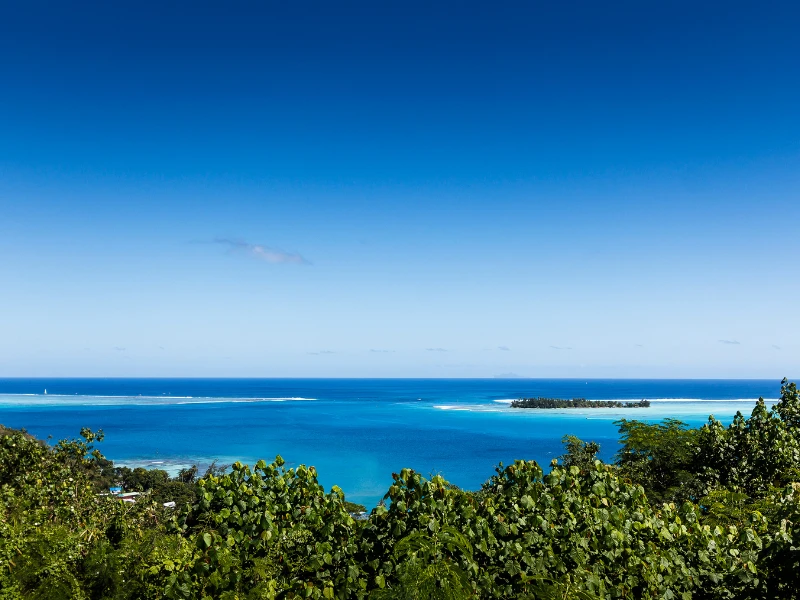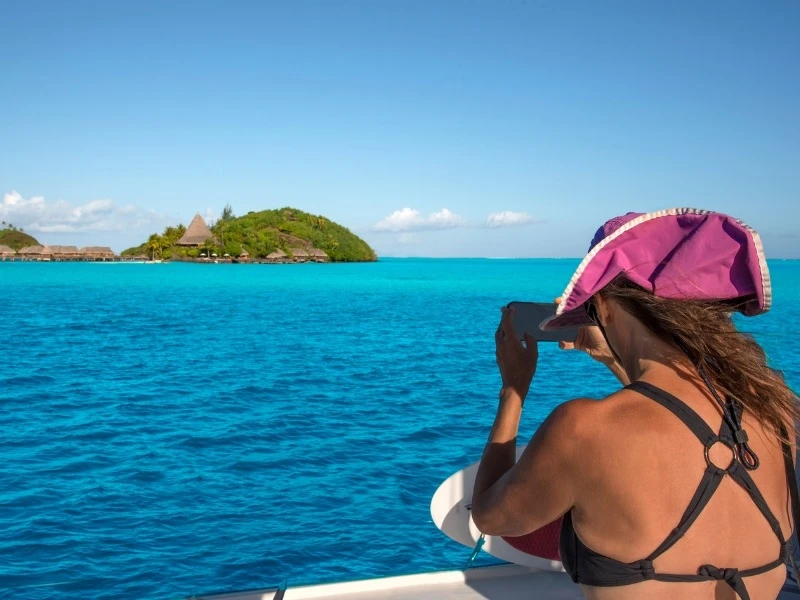
Would you like to experience surfing in Bora Bora? Nestled amidst the sparkling blue waters of the South Pacific Ocean, Bora Bora stands out as a tropical paradise like no other.
This enchanting island, a part of the Leeward group of the Society Islands in French Polynesia, is renowned for its breathtaking beauty and idyllic seclusion.
Located approximately 230 kilometers (140 miles) northwest of Papeete, the capital of French Polynesia, Bora Bora is a haven for travelers seeking tranquility, adventure, and a taste of island life.
Surfing enthusiasts might wonder if Bora Bora is a good place for surfing. While Bora Bora may not be the first name that comes to mind for surfers chasing massive waves, the island boasts its unique charm.
The coral formations on this island, surrounded by a mesmerizing lagoon, have a fascinating impact on the surf conditions. Although the waves here may not be as colossal as in other surfing destinations, they offer an intimate and unforgettable experience.
Besides, after exploring the bustling waves of Tahiti, many surf enthusiasts find their way to Bora Bora. This exhilarating sport harnesses the same powerful winds that may provide you with an unforgettable experience. Let’s explore everything you need to know about surfing in Bora Bora.
Spots Where You Can Surf in Bora Bora
When it comes to surfing in Bora Bora, you may not find many surf spots, but the existing ones offer unique experiences in this tropical paradise. Let’s explore two of the most notable surfing locations on the island:
Teavanui Pass

The Teavanui Pass is the crown jewel of Bora Bora’s surf spots. This spot is located near Motu Ahuna, on the southern side of Pearl Beach Resort. From May to October, Bora Bora receives dry-season swells.
This spot is a classic reef break, producing both left and right-hand waves. The waves can range from mellow to powerful, depending on the swell and tide conditions.
Teavanui Pass is best suited for intermediate to advanced surfers due to its challenging waves and potential hazards like coral reefs. Waves surge through the reef channel, creating tall, curved walls with tight, tube-like sections, gradually transforming into incredible waves measuring over 100 meters long.
Conversely, the right wave prefers cyclone swells in the wet season but is known to be a more challenging and unpredictable ride.
You’ll need a boat to reach Teavanui Pass. You can inquire about boat rentals at your hotel. However, this spot is only suitable for advanced surfers due to its powerful and demanding waves.
Motu Piti Aau

Motu Piti Aau, another surf spot in Bora Bora, lies on the opposite side of the archipelago from Teavanui Pass.
Motu Piti Aau is a small islet located just off the southern tip of Bora Bora. The place is accessible by a short boat ride. There is a reef break that produces hollow, fast waves that can be surfed left- and right-handed. It’s a great place to go with your friends to have fun and an experience you’ll never forget.
Motu Piti Aau is suitable for intermediate to advanced surfers comfortable with reef breaks and hollow waves.
What sets Motu Piti Aau apart is its remote and untouched nature. The lack of crowds and the pristine surroundings make it a surfing paradise. Surfers can enjoy the solitude of the waves and a breathtaking view of Bora Bora’s lagoon.
The take-off is fast and unforgiving, and a poorly angled paddle can lead to an unfortunate encounter with the rocky bottom. The steep wave can even barrel, ultimately funneling into a narrow channel.
While Motu Piti Aau may not be as accessible or consistent as Teavanui Pass, it offers a unique surfing experience for those willing to tackle its challenges. In Bora Bora, Teavanui Pass takes the spotlight for accessibility and popularity.
Important Facts you need to know About surfing in Bora Bora

1) Bring Your Surfboard
One crucial aspect to consider when planning a surfing adventure in Bora Bora is the availability of surfboard rentals. Unlike some popular surf destinations, Bora Bora lacks surfboard rental services on the islands.
This means that if you’re an avid surfer, it’s essential to bring your surfboard along for the trip. Having your board with you will ensure you’re prepared to surf the island’s unique waves.
2) Limited Surfboard-Friendly Airlines
Not all airlines are created equal when accommodating surfers and their boards. In Bora Bora, only one airline permits passengers to carry their surfboards, and that’s Air Tahiti Nui.
However, it’s important to note that Air Tahiti, another common airline in the region, does not accept surfboards as part of their baggage allowance. Therefore, if you’re flying to Bora Bora with your surfboard, choose Air Tahiti Nui to ensure a hassle-free journey with your beloved board.
What is the best time to Surf in Bora Bora?
The best time to surf in Bora Bora is from March to June. This is when the dry season is in full swing, bringing big SW groundswells (waves) to the South Seas. These waves are just right for reaching the reefs around Teavanui Pass, one of the top surf spots in Bora Bora.
If you’re looking for more waves, you can also surf on the eastern islands during December and January when strong cyclone storm swells hit the area. This time of year, however, can be unpredictable, with more rain and onshore winds.
Kite Boarding and Kite Surfing in Bora Bora: Riding
the Winds in Paradise

In the enchanting waters of Bora Bora, there’s more than just traditional surfing – it’s a playground for kite boarding and kite surfing enthusiasts. These exhilarating water sports share the thrill of harnessing the power of the wind but differ in the boards they use.
Kitesurfing takes on the waves with a directional board, allowing riders to ride the ocean’s swells with finesse. It’s a dance with the waves, a perfect choice when the conditions are just right.
On the other hand, Kiteboarding unleashes its riders on a flat-water surface using a twin-tip board. It’s all about the thrill of being propelled across the water’s surface by the sheer force of the wind.
When the classic surfing conditions in Bora Bora aren’t at their best, kite boarding and kite surfing emerge as fantastic alternatives. Both sports rely on the power of the wind to propel riders across the water, whether it’s a calm, flat surface or the rolling waves of the South Seas.
Depending on the wind speed, you can experience speeds that may reach up to an adrenaline-pumping 63 miles per hour.
With its constant breezes and clear waters, Bora Bora provides the perfect canvas for those eager to explore kiteboarding and kitesurfing. The crystal-clear waters enhance the excitement of these sports and offer a unique perspective of the underwater world.
The transparency of Bora Bora’s waters allows visitors and surfers to enjoy a clear view of the mesmerizing coral reefs that make up the marine ecosystems surrounding these islands. As you ride the wind and waves, you’ll also glimpse the vibrant and diverse underwater life that thrives beneath the surface.
So, whether you’re an experienced kiteboarder or kitesurfer or looking to dive into these thrilling sports for the first time, Bora Bora’s inviting waters and steady winds create the ultimate setting for an unforgettable adventure.
Surfing Lessons Opportunity in Bora Bora

While Bora Bora offers a captivating surfing experience, it’s essential to be aware that there are no officially registered surf schools on the island.
This means you won’t find the typical surf schools with structured lessons and certified instructors like in other surfing destinations. You can check Bora Bora Stall Up Paddle for learning wakeboarding and standup paddle.
If you’re eager to master kitesurfing in Bora Bora, you can go for Kite Surf School Polynesie. This school is located at Matira Point and offers a stunning backdrop of white sand beaches, lagoons, and vibrant surroundings.
Whether you’re a beginner or an experienced kitesurfer, the school welcomes all levels of enthusiasts and provides comprehensive lessons.
With excellent reviews, they guarantee that even first-time learners will ride the waves after their initial sessions, which typically last around 2 hours and are loads of fun.
The school equips learners with all necessary gear, including safety equipment, and operates in all weather conditions. In addition to kitesurfing, they offer courses in kiteboarding, wing foil boarding, wakeboarding, water skiing, as well as activities like tubing and stand-up paddle tours.
The local surf community in Bora Bora is friendly and welcoming to visitors. Many locals are willing to assist and guide tourists on surf excursions for a reasonable fee.
These knowledgeable locals can help you navigate the best surf spots, share insights on wave conditions, and ensure you have a safe and enjoyable time riding the waves.
Best Surfing Near Bora Bora

If you are satisfied with the surfing facilities in Bora Bora, you can check the nearest place to get your experience. Raiatea and Huahine offer exceptional surfing experiences. These two places are within 100 kilometers of Bora Bora.
Surfers will enjoy the extended surf season, consistent waves, and an ideal setting in these captivating destinations. Don’t forget to prepare for powerful, hollow, towering waves in Huahine.
You’ll need a quick take-off and high expertise in your sport to conquer these waves. We recommend a shuttle service to access the prime surf spots in Huahine or Raiatea. Navigating the strong currents near these islands can be challenging, making self-driving a boat not advisable.
Conclusion
Hope you got a complete idea about surfing in Bora Bora. You have to keep all these in mind if you are considering going surfing in Bora Bora. Make sure you plan ahead and keep your surf board with you. Further, the place is unsuitable for beginners or those with little knowledge of surfing.
It’s important to respect the locals’ sentiments about their waves. Some may be protective of their surf spots, so introduce yourself, be friendly, and kindly ask permission before catching a wave. Most locals are
welcoming, and your friendly approach may lead to shared post-surf moments.
FAQs
Can I rent a surfboard in Bora Bora?
Currently, no services are available for rent surfing board in Bora Bora. Your best option is to bring your surfboard with you. As mentioned, Air Tahiti Nui is accustomed to travelers carrying their boards, and they won’t charge you extra for it.
Does Bora Bora have big waves?
Bora Bora may not be renowned for its massive waves, but it still offers a delightful surfing experience.
What makes Polynesia ideal for surfing?
Polynesia’s appeal for surfers lies in its enviable exposure to consistent south swells that deliver waves all year round. This ideal wave climate creates a haven for surfers, allowing them to enjoy their passion without worrying about seasonality or unpredictable surf conditions.
Where can you surf in Bora Bora?
Surfing enthusiasts visiting Bora Bora have two standout locations to ride the waves. Teavanui Pass is one of the primary spots, offering a variety of wave conditions suitable for different skill levels. Additionally, just off the reef behind Motu Pitiaau, you’ll find another fantastic surfing area.
How deep do you have to be to surf?
The ideal depth for surfing largely depends on the specific surf spot and wave conditions. Surfers typically need water depths of at least a few feet to ride waves comfortably.
This depth provides the necessary buoyancy for surfboards and allows surfers to safely navigate and enjoy the waves. According to the expert surfers it’s best to find a wave that breaks in at least four feet of water.
Is there good surfing in Bora Bora?
Yes, of course. Bora Bora is home to some remarkable surf opportunities, and one of the standout spots is the left break-off Teavanui Pass. Even though Bora Bora doesn’t have colossal waves, its picturesque surroundings, warm waters, and joy of riding waves make it a great place for surfing.
